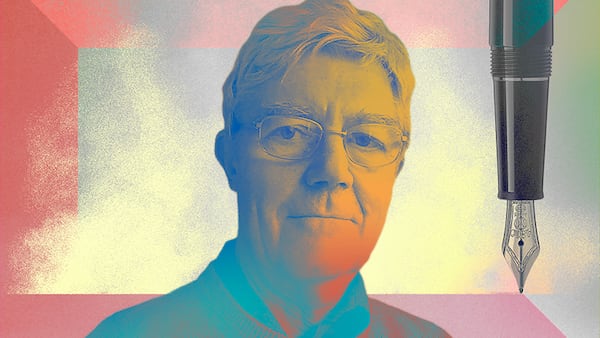- The underlying principle of Bitcoin and most of crypto is "Don’t Trust, Verify."
- Why, then, are some people willing to believe false information?
- What forms can it take? How does it spread? And how can journalists avoid it?
Robert Holloway is a columnist and ombudsman at DL News. Views expressed are his own.
Sam Bankman-Fried’s conviction earlier this month left people wondering why so many had believed in him for so long.
Then there was XRP — the value of the token briefly soared a few weeks ago on what turned out to be a fake filing suggesting that BlackRock would seek government approval for an exchange-traded fund tracking the token.
There are more examples.
Tim Harford, a columnist for the Financial Times who has made a study of false news, draws a distinction between misinformation and disinformation.
Like other journalists and academics who have written much on the subject, Harford prefers to avoid the term fake news.
Two years after Collins Dictionary made the expression its word of the year in 2017, Harford argued in an article for the Financial Times that it was already debased.
The then-US President Donald Trump had made it a term of political abuse. Others used it to encompass such a broad range of things, including satire, jokes and advertising claims, that it had ceased to have any precise meaning, Harford said.
“Disinformation is deliberate,” he told me in an e-mail. “It starts because somebody lied, perhaps to promote an ideology, perhaps to sell something, or to win an election. Misinformation is accidental: People make a mistake and other people copy them.”
Asked why false news spreads, Harford replied: “For the same reason that accurate information sometimes spreads: because it’s exciting, surprising, emotionally-resonant, allows people to signal their political affiliations, etc.”
There is, however, something particularly compelling about falsehood. As the adage has it: “A lie will go around the world while Truth is putting her boots on.”
For those with the benefit of hindsight, it is hard to understand why that is so.
The jury in Bankman-Fried’s trial in New York had no difficulty reaching a verdict. It took them less than five hours to find him guilty on seven charges that included conspiracy and money laundering.
He was convicted less than a year after his company FTX, once valued at $32 billion, filed for bankruptcy.
Commenting for The New York Times, cryptocurrency researcher Molly White wrote: “When the next company in its position falls, the only surprise should be that people expected any other outcome.”
Peter Cunliffe-Jones, a visiting researcher at Westminster University, London, has identified five factors which encourage people to believe a claim.
First, “A claim is more likely to be seen as credible if perceived to be plausible,” he told DLNews. In other words, if it is “both consistent in its internal logic and presentation, and coherent with precedents and perceived external evidence.”
The false BlackRock filing was plausible partly because the crypto-sphere is buzzing with speculation that the US Securities and Exchange Commission will soon approve such a request.
As we have reported, at least 12 applications are pending for a Bitcoin spot ETF.
The easier a claim is to digest can also affect people’s judgment, Cunliffe-Jones said. “The larger the font size, the simpler the language used, the greater the use of familiar visual images, the more quickly and superficially it is likely to be assessed.”
The false filing, reproduced in our story Fake BlackRock filing sends XRP on rollercoaster, is a model of clarity.
The third factor is the emotional strength of a claim.
“The susceptibility of audiences to information that arouses emotional responses or aligns with pre-existing views is well known,” Cunliffe-Jones said.
It is exploited by those who “spread fake news, seek an audience for hoaxes and scams, and spread disinformation to deceive.”
Tim Harford urges reporters and others to be alert to their emotional reaction to a claim.
“Once you’ve noticed that you are fearful, angry, or otherwise excited, your emotions lose a bit of their power and you can think more clearly,” he wrote.
“Be calm” is one of the three Cs recommended by Harford in his latest book, “The Truth Detective.” The others are context and curiosity.
The perceived credibility of a source is the fourth factor identified by Cunliffe-Jones, a board member of the International Fact-Checking Network. He emphasises the role of seemingly authoritative medical journals in promoting false information about vaccines.
The logo on the website of the Delaware State Department no doubt led many investors to suspend their critical faculties before buying XRP tokens last week.
Similarly, cover profiles such as Meet the world’s richest 29-year-old published in October 2021 by Forbes, one of the most influential business magazines, helped build Bankman-Fried’s bubble reputation.
The image of the frizz-haired financial genius — a kind of Einstein of the crypto world — was repeated time and again by other publications.
But, as Cunliffe-Jones notes, repetition is another way to propagate false information.
“In 1945, a famous study found that people who had already heard a given rumour were more likely to believe it when they heard it again than those hearing the same rumour for the first time,” he said.
An important counter to false information is fact-checking. Since most codes of journalistic ethics insist on the need for accuracy in reporting, it may surprise many readers that fact-checking is a very recent phenomenon.
When I began my career in journalism in 1973, most reporters thought that accuracy meant quoting a source verbatim and in context. It was rare to challenge the content of what they said. In some editorial guidelines and stylebooks, official sources ranked highest in the hierarchy of information providers.
Times have changed, fortunately. The non-profit Poynter Institute set up the International Fact-Checking Network in 2015. It has attracted so much interested attention, applications for membership were paused this year.
An excellent starting point for a fact-checker is “Get Context,” the second of Tim Harford’s Cs.
“That can mean anything from ‘Where is this claim actually coming from?’ to ‘Do I even understand what is being said?’” he wrote.
His third C is curiosity. “It is much better to treat a claim as a starting point for understanding the world than as investment advice or a weapon in an argument,” he added.
Do you have any views about misinformation in crypto? You can share them with me at robert@dlnews.com





